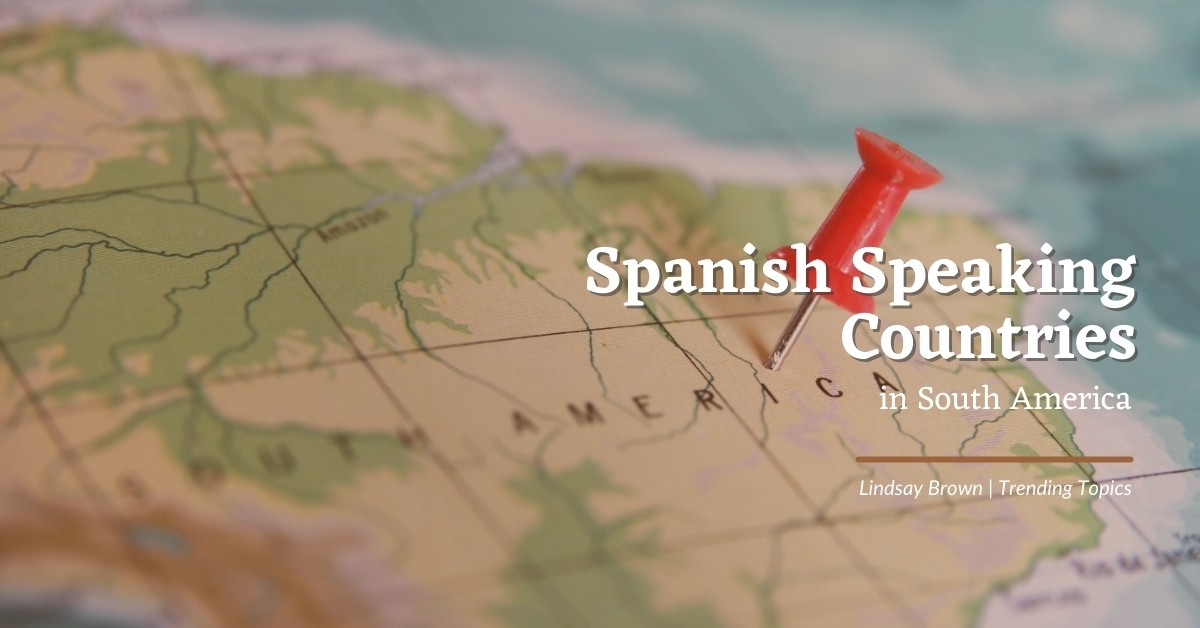
Spanish-Speaking Countries in South America
Extraordinary landscapes. Fascinating cultures and peoples. Jaw-dropping snowy mountain peaks. Salt flats that transform into mirrors of the night sky.
Given these points, it’s no wonder that South America is a top destination for travelers, explorers, and students the world over. If you are learning to speak Spanish, practice your skills by visiting some (or all!) of the nine Spanish-speaking countries in South America. Surely, this won’t prevent you from traveling to the four South American countries that do not officially speak Spanish. However, for the sake of language learning, let’s first dive into the countries that do. Together we’ll find out where Spanish fluency can take you in South America!
Which countries in South America are Spanish-speaking?
Of the thirteen countries in the South American continent, there are nine countries whose official language is Spanish. They are Argentina, Bolivia, Chile, Colombia, Ecuador, Paraguay, Peru, Uruguay, and Venezuela. Where would you like to go to practice your Spanish skills?

Argentina
Capital: Buenos Aires
Population: 40,091,359
Government: Republic
Famous For: Natural wonders, unique dialect, tango

Argentina has an impressive number of natural wonders, from glacial lakes to dusty deserts. It is home to the highest peak of the Andes, a mountain range labeled the longest in the world. Uniquely, the Spanish spoken in Argentina is different from other Spanish-speaking countries because it is more similar to the pronunciation and rhythm of Italian. If you wish to study Spanish formally in Argentina, there are many Spanish immersion courses offered in big cities. For example, try places like the capital, Buenos Aires, or Mendoza, where you will learn the special dialect of Argentina. You can even learn to tango or to cook empanadas while you’re there!
Read more: The 7 Most Remarkable Natural Wonders of Argentina (plus 21 more!)
Bolivia
Capital: La Paz
Population: 11,283,636
Government: Constitutional
Famous For: Large indigenous population, diverse cultures, Spanish immersion
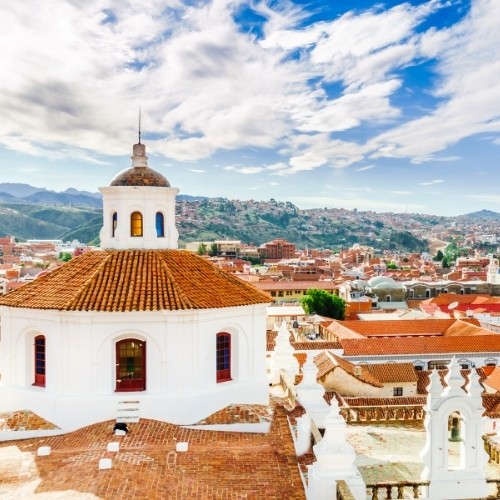
The rare treasures of Bolivia are found in its people. This is one of the Spanish-speaking countries with the largest percentage of indigenous groups. With this in mind, finding community-based tourism and local guides will allow you to learn about the customs, traditions, and native languages of over 30 indigenous groups. Interestingly, as a landlocked nation, Bolivia overcomes its blockage to the sea by positioning its navy forces in a base at the highest navigable lake in the world, Lake Titicaca. This lake is located along the western altiplano (“high plateau”) at 12,500 ft. above sea level. Given that English is not widely spoken in Bolivia, it is an excellent country to visit for deep Spanish immersion. You’ll be thrust into scenarios where only your Spanish skills can help you!
Chile
Capital: Santiago
Population: 18,258,087
Government: Republic
Famous For: Friendly, relaxed attitude, numerous beaches & ski resorts, wine culture
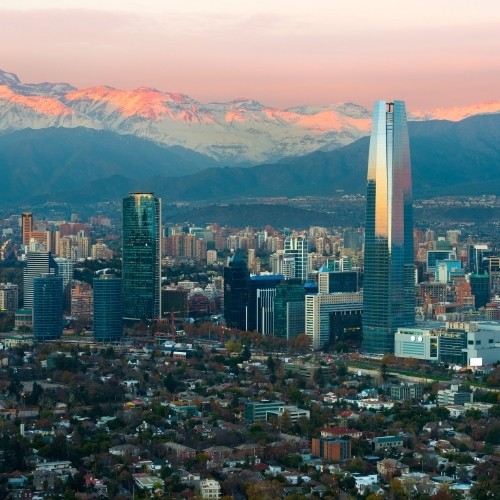
Chilean culture adopts rest and relaxation as foundations of a good life. As a result of this attitude and their world-famous wines, it is clear that Chile is the best place for slow travel among Spanish-speaking countries. Surprisingly, Chile only measures 175 km east to west while being flanked by the Andes and the Pacific Ocean. This gives the feeling of closeness even after a short stay in one area. Significantly, the famous Easter Island is a historical island off the coast where the longest cave system in the world exists. Rivers of lava carved out the caves that now lie under the rocky terrain. Take advantage of the homestay option if you choose to study Spanish in Chile! You can live temporarily with a local family who will show you the true meaning of Chilean culture, which is to create lasting friendships and enjoy every moment.
Read more: A Beginner’s Guide to Chile: Culture, History, Language, and More
Colombia
Capital: Bogotá
Population: 49,634,035
Government: Unitary Republic
Famous For: mysterious archaeology, clearly spoken Spanish

Colombia is the only South American country with coastlines on both the Pacific Ocean and the Caribbean Sea. This scenic country features heaps of archaeological ruins, dating back 13,000 years. Whispers of a lost civilization amaze us even today with their mystery. Above all, the city of Ciudad Perdida and the underground tombs called Tierradentro are great examples of this. Even though the country has suffered political unrest and civil warfare, it has been gaining economic ground and a growing sense of stability for some time. Colombians would say that “Colombian Spanish” is the clearest of all Latin Spanish-speaking countries. Due to its slow pace and cautious spoken word, it is easy to understand. There are many options to continue your Spanish studies in the capital, Bogotá. This is where you will find plenty of private tutors, college professors, and professional teachers.
Ecuador
Capital: Quito
Population: 16.4 million
Government: Democratic Presidential Republic
Famous For: biodiversity, quality of life, The Amazon Rainforest
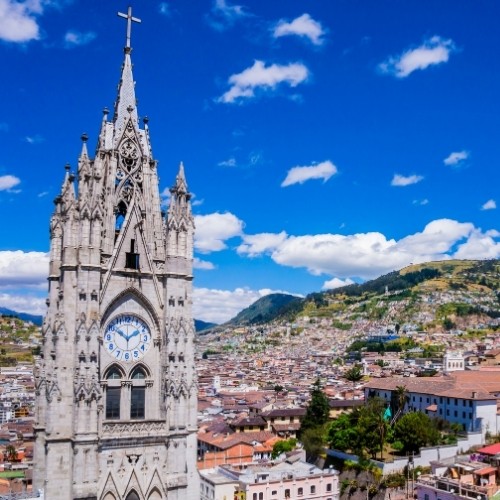
Ecuador, home of the Amazon Rainforest, is the most bio-diverse of the Spanish-speaking countries. Due to the multitude of diversified life in areas such as the Galápagos Islands, Charles Darwin was able to explore and create his theory of evolution. According to InterNations, Ecuador has been voted the “best country for expats” for two consecutive years due to the high quality of life and a decent cost of living it provides. Moreover, Ecuador offers Spanish-learners affordable, fun, and professional education that promotes language learning in a lively environment.
Read more: A Traveler’s Guide to Ecuador: Culture, Language, and History
Paraguay
Capital: Asunción
Population: 7 million
Government: Representative Democratic Republic
Famous For: Atlantic Forest

Paraguay is the only country in South America that is not a big tourist destination. In fact, tourism is so rare here that hostels, public transport, and any other tourism supports are simply not offered. However, the country features the Atlantic Forest, which runs from Brazil to Argentina, passing through Paraguay. Due to wildlife conservation projects, it is a popular attraction for biologists and environmentalists. For the strong-willed, it’s a perfect place to immerse yourself in Spanish because there are very few English speakers.
Peru
Capital: Cusco
Population: 32 million
Government: Unitary Presidential Republic
Famous For: Machu Picchu, Nazca Lines, Amazon Rainforest

Home to the famous Machu Picchu and Nazca lines, Peru has an aura of mystery, excitement, and adventure. Equally important, this country offers a foodie experience like no other. It has been nicknamed “the capital of Latin cooking” because its unique dishes combine influences from all over the world. Due to a lack of slang and regional accents in Peruvian Spanish, this is a great place to practice with locals. You can also explore one of the most interesting civilizations on the planet while you learn!
Uruguay
Capital: Montevideo
Population: 3.5 million
Government: Constitutional
Famous For: Low corruption, excellent economy, beautiful beaches
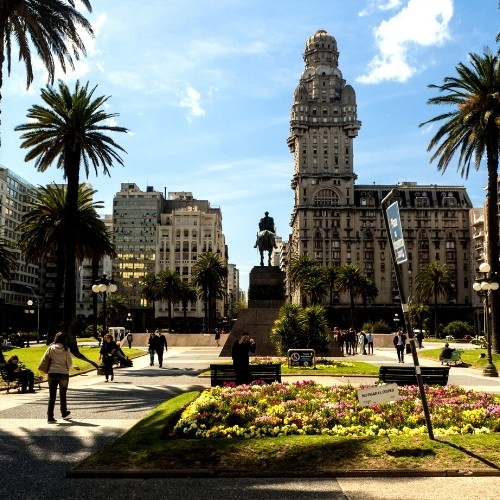
In a country where cows outnumber people four to one, you may think this nation is a bit backward. On the contrary, Uruguay is one of the most progressive, stable, and prosperous Spanish-speaking countries in South America. Because of its booming middle class, responsive government, and powerful free press, this country provides a strong model for the rest of the world to follow. Additionally, the most popular destination for learning Spanish in Uruguay is in the capital, Montevideo. You can enjoy the city life or spend the day at the beach before you partake in evening Spanish classes.
Venezuela
Capital: Caracas
Population: 32 million
Government: Constitutional Republic
Famous For: Diversity of natural beauty
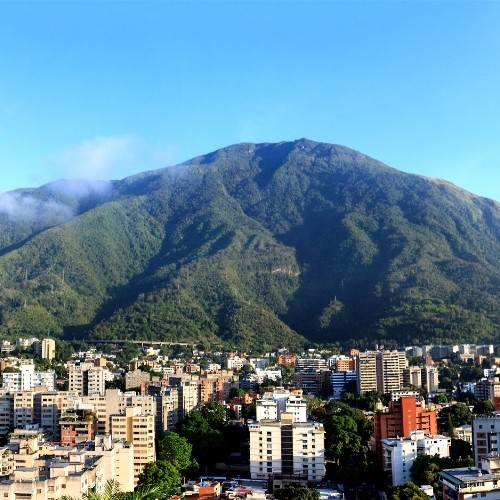
Even with years of political and economic friction in this great country, Venezuela is still home to some of the most charming natural beauties. From the snow-covered Andean peaks to the sunny coast of the Caribbean, Venezuela holds great pride for its many distinct features. Grasslands, islands, and waterfalls are among the many unique gems that this country has to offer. Sadly, travel at the present moment is not advised due to grave economic problems.
The Four “Don’t” Countries
Can you identify the four countries of South America that weren’t mentioned? The following countries are vital parts of the continent’s identity and culture. However, they do not consider Spanish to be their primary language of communication in society and/or official government business. These countries are Brazil (Portuguese), Guyana (English), Suriname (Dutch), French Guiana (French). You can visit these countries and use your Spanish to get by, but expect to say more with your hands than your mouth!
Sharpen Your Spanish as You Travel
In summary, a great way to sharpen your Spanish skills outside of the classroom is to visit the nine Spanish-speaking countries in South America. By exploring what each country has to offer, you can find which one suits your personality and traveling style. Above all, studying Spanish online or in the classroom is an open door to new places and experiences that will boost your understanding of the world. ¡Hagámoslo!
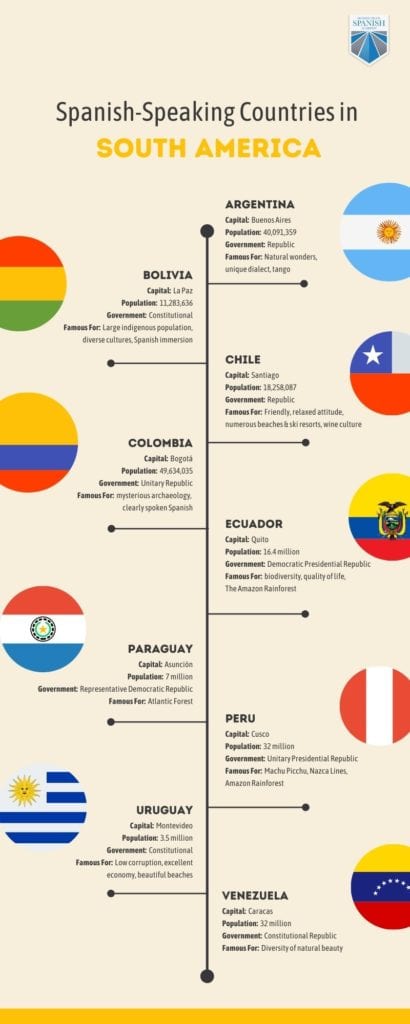
Build Your Vocabulary While Reading
Before you start planning for your big trip to South America, download Homeschool Spanish Academy’s free eBook for beginners called Weird & Wacky Spanish Stories for Beginners! It’s best suited for A2 level and above, but it’s also perfect for A1 learners who wish to improve their fluency through reading. It’s fun for kids and adults!

Get Your Free Copy of Weird & Wacky Spanish Stories for Beginners
Type in your name and email to get 6 weird, wacky, and super entertaining Spanish stories for you and your family! Enjoy a magazine-style eBook with pictures and English-Spanish parallel text. Start reading in Spanish today!

Do you love Spanish culture? Then you’ll love these:
- French vs Spanish: 7 Reasons Spanish Could Be a Strong Long-Term Investment
- 7 Creative Ways to Maintain Spanish Fluency at Home — Perfect for Elementary Kids
- The Best Spanish Learning Podcasts for Kids
- Raising a Bilingual Child: 10 Must-Have Resources Every Parent Needs
- 5 Proven Strategies to Help Your Middle Schooler Excel in 1-on-1 Online Spanish Classes
- 10 Expert Tips to Keep Your Middle Schooler Motivated in Online Language Lessons
- 5 Fun & Easy Spanish Activities to Do at Home with Your Preschooler
- The Best Spanish Learning Apps, Books, and Games for Kids
- Top-Rated Accredited Online Spanish Classes for Kids - February 22, 2023
- 6 Compelling Reasons Why Your School Should Outsource Spanish Class - February 3, 2023
- 20 Free Spanish Books, Novels, and Stories in PDF and Printables - January 25, 2023




